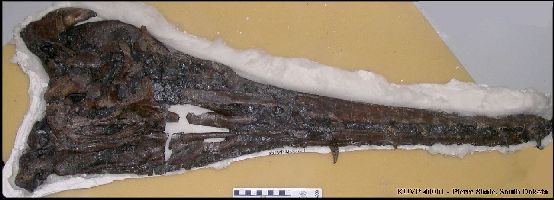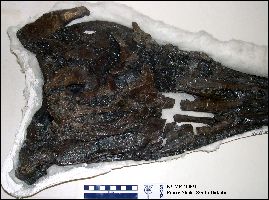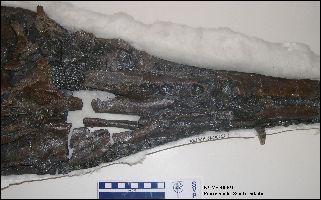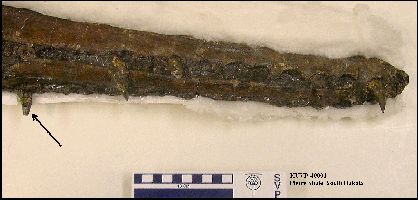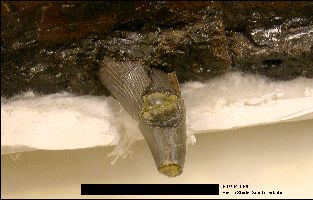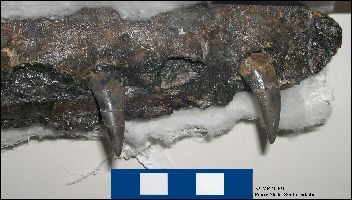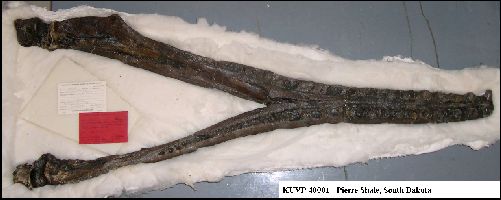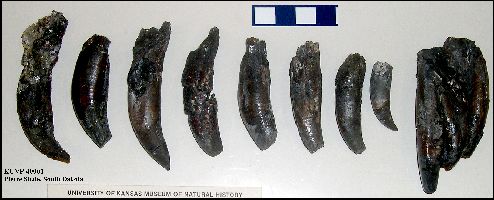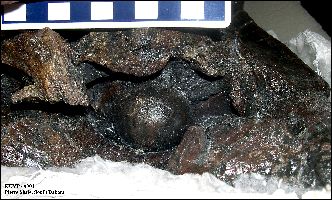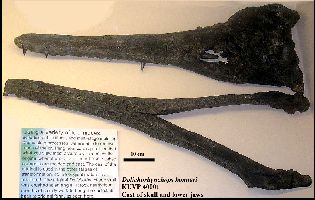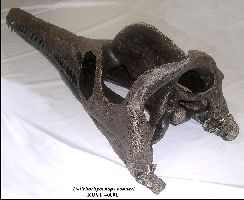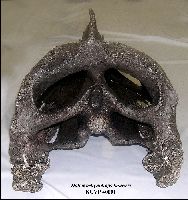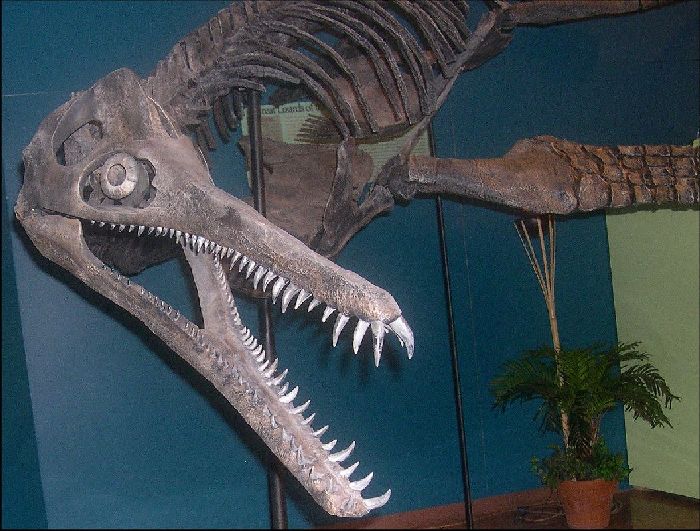 |
Dolichorhynchops bonneri
KUVP 40001
A large polycotylid from the Pierre Shale (Lower
Campanian) of South Dakota, U.S.A.
Copyright © 2006-2009
by
Mike Everhart
Page created 03/25/2006
Last Updated 03/22/2009
LEFT:
The reconstructed skull of Dolichorhynchops as displayed at the Rocky Mountain Dinosaur Resource Center. The original specimen
(KUVP 40001) is in the collection of the University of Kansas Museum of Natural History,
Lawrence, Kansas. |
The skull of this specimen (KUVP 40001) was collected from the Sharon Springs
Member of the Pierre Shale of South Dakota in the 1970s. Another specimen, a relatively
complete set of post-cranial remains (KUVP 40002) was collected about four miles away in
Niobrara County, Wyoming. Together, the two specimens were initially described as a
new species, "Trinacromerum bonneri," by Dawn A. Adams in 1997. At
about the same time, however, Ken Carpenter (1996) re-described Trinacromerum and
Dolichorhynchops, and chronologically limited Trinacromerum to specimens
occurring from the Cenomanian through the Turonian (see also Schumacher and Everhart, .
Carpenter (1996) also identified KUVP 40001 as Dolichorhynchops osborni.
According to Carpenter, and based on extant specimens at the time, the first occurrence of
Dolichorhynchops was in the lower Campanian Smoky Hill Chalk and extended into
the lower Pierre Shale. This implies a gap of about 3 million years between the last known
occurrence of Trinacromerum bentonianum and the first known occurrence of Dolichorhynchops
osborni. More recently, the gap between the two genera has been narrowed
somewhat by fragmentary specimens reported by Everhart (2003) in the upper Coniacian Smoky
Hill Chalk and the recent discovery of cf. Dolichorhynchops remains in the lower
Coniacian Fort Hays Limestone of Jewell County, KS (Everhart, Decker and Decker, 2006).
Based on Carpenter's (1996) analysis, it can be assumed that the specimen
represents the genus Dolichorhynchops, and not Trinacromerum. However,
since the specimen was described and named by Adams (1997) as a new species, there is
still some confusion regarding the species name (bonneri). As of December, 2007,
the issue had not been formally resolved. In any case, KUVP 40001 and 40002
represent two of the largest polycotylids known from the Western Interior Sea.
Besides KUVP 40001 and the three specimens from the Smoky Hill Chalk, there are
four skulls of polycotylids identified as Dolichorhynchops from the Pierre Shale
(Carpenter, 1996): UCM 35059 (Sharon Springs Member, Pierre Shale, Red Bird, Niobrara
County, Wyoming); AMNH 5834 (Sharon Springs Member, Pierre Shale, Red Bird, Niobrara
County, Wyoming); UNSM 50133 (Sharon Springs Member,
Pierre Shale, Hat Creek drainage, Fall River County, South Dakota); and UNSM 55810 (a small juvenile skull from the Sharon
Springs Member, Pierre Shale, Hat Creek drainage, Fall River County, South Dakota).
KUVP 40001 was collected from the Wallace Ranch (about 10 feet below the Ardmore
Bentonite, Sharon Springs Member, Pierre Shale, Hat Creek drainage, Fall River County,
South Dakota) while KUVP 40002 was collected from the Johnson Ranch, northeast of Redbird,
Niobrara County, Wyoming about 10 feet above the Ardmore Bentonite, Sharon Springs
Formation, Pierre Shale Group.
| Dolichorhynchops skulls* |
Length
|
Occurrence |
| UNSM 55810 |
34 cm |
Pierre Shale - Lower Campanian, South Dakota |
| UCM 35059 |
45 cm |
Pierre Shale - Lower Campanian, Wyoming |
| MCZ 1064 (2) |
47 cm |
Smoky Hill Chalk, Lower Campanian, Kansas |
| FHSM VP-404 |
51.3 cm |
Smoky Hill Chalk, Lower Campanian, Kansas |
| KUVP 1300 (Holotype - skeleton) |
57 cm |
Smoky Hill Chalk, Lower Campanian, Kansas |
| UNSM 50133 |
61.8 cm |
Pierre Shale - Lower Campanian, South Dakota |
| AMNH 5834 |
74.5 cm |
Pierre Shale - Lower Campanian, Wyoming |
| KUVP 40001 (below) |
98 cm |
Pierre Shale - Lower Campanian, South Dakota |
| * Data from Carpenter,
1996 and Everhart, 2004 |
The following pictures of the specimen were taken recently (11/2007) in the
collections of the University of Kansas Museum of Natural History.
The skull of KUVP 40001 was prepared out by Triebold Paleontology (Woodland Park,
Colorado) and re-inflated to produce an accurate reconstruction (See
my web page about the Rocky Mountain Dinosaur Resource Center for more views of the
combined specimens (KUVP 40001 and 40002)). The following pictures, except as noted, of
the reconstructed skull were taken in the spring of 2006 at a Gem and Mineral show in
Kansas City.
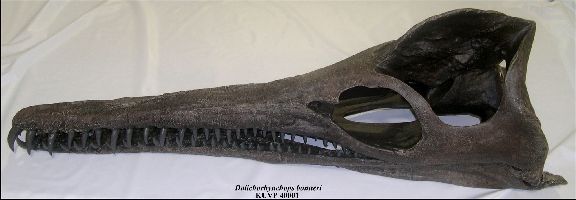 |
LEFT: The reconstructed skull of Dolichorhynchops bonneri
(KUVP 40001) in left lateral view. The lower jaw measures about 97 cm. This is the largest
known skull of Dolichorhynchops. Another view is here. |
 |
LEFT: Cast of the left rear-paddle of KUVP 40002, a polycotylid
from the Pierre Shale of South Dakota. |
References:
Adams, D. A. 1977. Trinacromerum bonneri, a new polycotylid plesiosaur
from the Pierre Shale of South Dakota and Wyoming. Unpublished Masters thesis,
University of Kansas, 97 pages.
Adams, D. A. 1997. Trinacromerum bonneri, new species, last and
fastest pliosaur of the Western Interior Seaway. Texas Journal of Science, 49(3):179-198.
Bonner, O. W. 1964. An
osteological study of Nyctosaurus and Trinacromerum with a description of a
new species of Nyctosaurus, Unpublished Masters thesis, Fort Hays State University,
63 pages.
Brown, D. 1981. The English Upper Jurassic Plesiosauroidea (Reptilia) and a
review of the phylogeny and classification of the Plesiosauria. Bulletin of the British
Museum (Natural History), Geology 35: 253-347.
Carpenter, K.
1996. A review of short-necked plesiosaurs from the Cretaceous of the Western
Interior, North America, Neues Jahrbuch für Geologie und Paläeontologie Abhandlungen,
(Stuttgart) 201(2): 259-287.
Carpenter, K. 1997. Comparative cranial anatomy of two North American
Cretaceous plesiosaurs, pp. 191-216, In Calloway, J. M. and E. L. Nicholls, (eds.),
Ancient Marine Reptiles, Academic Press.
Everhart, M. J.
2003. First records of plesiosaur remains in the lower Smoky Hill
Chalk Member (Upper Coniacian) of the Niobrara Formation in western Kansas. Kansas
Academy of Science, Transactions 106(3-4):139-148.
Everhart, M. J. 2004.
New data regarding the skull of Dolichorhynchops osborni (Plesiosauroidea:
Polycotylidae) from rediscovered photos of the Harvard Museum of Comparative Zoology
specimen. Paludicola 4(3):74-80.
Everhart, Michael J. 2005. Oceans of Kansas - A Natural History of the
Western Interior Sea. Indiana University Press, 320 pp. ISBN:
0253345472
Everhart, M.J., Decker, R., and P. Decker, P. 2006. Earliest remains
of Dolichorhynchops osborni (Plesiosauria: Polycotylidae) from the basal Fort
Hays Limestone, Jewell County, Kansas.
Everhart, M. J. 2007. Sea Monsters: Prehistoric Creatures of the Deep.
National Geographic, 192 p. ISBN-13:978-1426200854
O'Keefe, F. R. 2008. Cranial anatomy and taxonomy of Dolichorhynchops
bonneri new combination, a polycotylid plesiosaur from the Pierre Shale of Wyoming
and South Dakota. Journal of Vertebrate Paleontology 28(3): 664-676.
Sato, T. 2005. A new polycotylid plesiosaur (Reptilia: Sauropterygia) from the
Upper Cretaceous Bearpaw Formation in Saskatchewan, Canada. Journal of Paleontology 79(5):
969-980.
Schumacher, B. A. and Everhart, M.J. 2005. A stratigraphic and taxonomic review of
plesiosaurs from the old “Fort Benton Group” of central Kansas: A new assessment
of old records. Paludicola 5(2):33-54.
Sternberg, G. F. and Walker, M.V. 1957. Report on a
plesiosaur skeleton from western Kansas. Kansas Academy of Science, Transactions,
60(1):86-87.
Williston, S. W. 1902. Restoration of Dolichorhynchops osborni, a new
Cretaceous plesiosaur, Kansas University Science Bulletin, 1(9):241-244, 1 plate.
Williston, S. W. 1903. North American Plesiosaurs. Field Columbian Museum, Pub.
73, Geological Series, 2(1):1-79, 29 plates.


